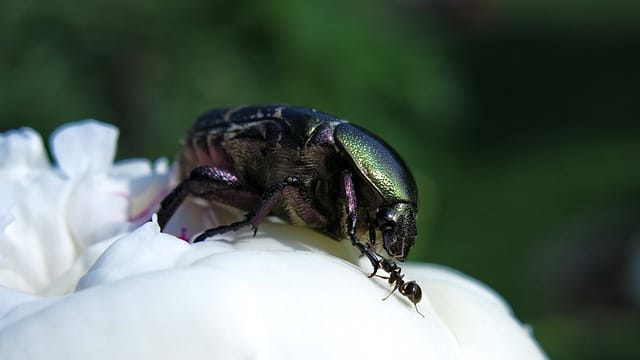Fighting gardening diseases: Rose chafers
Rose chafers (Macrodactylus subspinosus) are highly destructive insects that can cause significant damage to garden plants, particularly roses and other flowering plants

In this article:
- Introduction to Rose Chafers
- Identification of Rose Chafers
- Signs and Symptoms of Rose Chafer Infestation
- Understanding the Life Cycle of Rose Chafers
- Common Plants Affected by Rose Chafers
- Precautionary Measures for Preventing Rose Chafer Infestation
- Natural Control Methods for Rose Chafers
- Chemical Control Options for Rose Chafers
- Removing and Managing Rose Chafers from the Garden
- Additional Tips for Rose Chafer Management
- Conclusion: Maintaining a Healthy Garden despite Rose Chafers
Introduction to Rose Chafers
Rose chafers (Macrodactylus subspinosus) are highly destructive insects that can cause significant damage to garden plants, particularly roses and other flowering plants. These beetles, which are native to North America, have a voracious appetite for the foliage, flowers, and even the petals of various ornamental plants. Therefore, it is crucial for gardeners to take proactive measures to identify and manage rose chafer infestations in order to protect their gardens from these pests.
Identification of Rose Chafers
Rose chafers are small, tan-colored beetles that measure about 0.5 to 0.8 inches in length. They have a distinctive 'C'-shaped body, with spiny legs and antennae. Their wings, which are hidden under wing covers, are transparent and flexible. These insects are most commonly active during the day, especially during warm and sunny weather.
Signs and Symptoms of Rose Chafer Infestation
Signs of rose chafer infestation include skeletonized leaves, flowers with missing petals, and defoliation of plants. The beetles feed on the juicy tissues of the plants, leaving behind lace-like foliage. Additionally, the presence of adult beetles, both on the plants and on the ground, is a clear indicator of infestation.
Understanding the Life Cycle of Rose Chafers
Rose chafers undergo complete metamorphosis, meaning they have four distinct stages: egg, larvae, pupa, and adult. The beetles lay their eggs in the soil during late spring or early summer. The larvae, also known as white grubs, feed on the roots of grasses and other plants, remaining underground for several months. In late spring of the following year, the larvae pupate and eventually emerge as adult rose chafers.
Common Plants Affected by Rose Chafers
Rose chafers are known to target a wide range of plants. Some of the most common plants affected by these pests include roses, peonies, grapes, cherries, strawberries, raspberries, and various other flowering plants and fruit trees.
Precautionary Measures for Preventing Rose Chafer Infestation
To prevent rose chafer infestations, it is important to implement certain precautionary measures. These include:
- Inspecting plants regularly for signs of beetles or damage.
- Removing any weeds or debris in the garden as they may attract beetles.
- Maintaining a healthy garden by providing adequate nutrition and proper watering.
- Using physical barriers such as netting to protect vulnerable plants.
- Limiting the use of fertilizers high in nitrogen, as these can attract beetles.
Natural Control Methods for Rose Chafers
Natural control methods can be used to manage rose chafers without the use of harmful chemicals. These methods include:
- Handpicking the beetles and dropping them into a bucket of soapy water.
- Encouraging natural predators such as birds, bats, and spiders in the garden.
- Using companion plants that repel rose chafers, such as garlic or chives.
- Applying diatomaceous earth around affected plants, as it dehydrates the beetles.
Chemical Control Options for Rose Chafers
If natural control methods are not sufficient, chemical control options can be used as a last resort. It is important to carefully follow the instructions provided by the manufacturer when using chemical pesticides. Some common pesticides that can effectively control rose chafers include pyrethroids, carbaryl, and neem oil.
Removing and Managing Rose Chafers from the Garden
In order to effectively remove and manage rose chafers from the garden, the following steps can be taken:
- Handpick adult beetles from plants early in the morning when they are less active.
- Apply physical barriers such as row covers to protect vulnerable plants.
- Remove any beetle-infested plant parts and dispose of them away from the garden.
- Implement a combination of natural and chemical control methods as needed.
Additional Tips for Rose Chafer Management
Here are some additional tips for managing rose chafers:
- Encourage biodiversity in the garden to attract natural predators of rose chafers.
- Monitor plants regularly for any signs of damage or infestation.
- Practice crop rotation to minimize the buildup of rose chafer populations in the soil.
- Avoid over-watering plants, as moist soil can attract beetles.
Conclusion: Maintaining a Healthy Garden despite Rose Chafers
While rose chafers can pose a threat to garden plants, with proper identification and proactive management strategies, it is possible to maintain a healthy garden. By implementing precautionary measures, utilizing natural control methods, and resorting to chemical options when necessary, gardeners can effectively combat rose chafers and safeguard their beloved plants.
